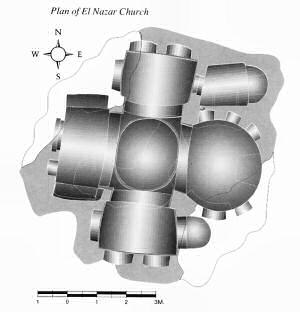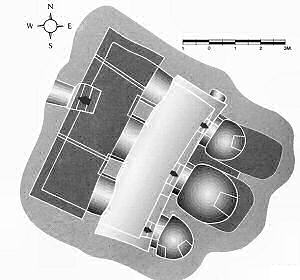|
This T-shape planned building cut into a fairy chimney, is situated
on a ridge that overlooks the gardens on the right-hand side when
coming to the Zemi
Valley from Göreme. The church has paintings dated to before the
10th century of scenes from the Bible, and depictions of saints. The
arches of the building are adorned with medallions.
Follow the streambed to the right of the Avcılar/Göreme road and,
on leaving it, go some 800 meters further to arrive at a large rock
in the form of a kind of tent. This is one of the most interesting
churches in he whole Göreme region, called El Nazar. Hewn from an
isolated cone of rock, it is a cruciform church with vaults as the
three longer arms of the cross, and a horse-shoe shaped apse. There
are tombs in the east wing, and a basement into which the floor has
in large part collapsed, while the east wing is in complete ruins.
Despite these ravages of time, however, the paintings on the ceiling
are quite well preserved.
 Executed
on a straw-and-lime plaster surface, these paintings date from the
11th century. On the arches opening onto the side vaults from beneath
the central dome there is a series of rosettes depicting Old Testament
prophets, and another portraying the saints. The remaining surfaces
are devoted to the Life of Christ, from infancy through the miracles
to the Passion. This subject matter is in conformance with the style
Jerphanion terms archaic. Executed
on a straw-and-lime plaster surface, these paintings date from the
11th century. On the arches opening onto the side vaults from beneath
the central dome there is a series of rosettes depicting Old Testament
prophets, and another portraying the saints. The remaining surfaces
are devoted to the Life of Christ, from infancy through the miracles
to the Passion. This subject matter is in conformance with the style
Jerphanion terms archaic.
The paintings in this church are the handiwork of two artists, the
first of whom did the ceiling and one or two Bible scenes, for example
the Flight from Egypt. Flesh tones have been painted on a light green
background, with shadows and shading left green, while full light
is captured in white. Outlines are done in red.
The second artist worked on the west and north wings, as well as
the apse. In his work there is no green background. The flesh tones
are pinker, and eyes are outlined in white.
 Between
El Nazar and the main road, it stands on a ridge overlooking the valley.
Before it has been discovered in 1957, the entrance being closed with
rubble, the frescoes were preserved in a quite good condition, and
most of them painted directly on rock surface, are red. Among these,
dated to the second half of the 11th century, the scenes of Crucifixion,
Death of the Virgin, Metamorphosis, St. John the Baptist in the Desert
are interesting. Between
El Nazar and the main road, it stands on a ridge overlooking the valley.
Before it has been discovered in 1957, the entrance being closed with
rubble, the frescoes were preserved in a quite good condition, and
most of them painted directly on rock surface, are red. Among these,
dated to the second half of the 11th century, the scenes of Crucifixion,
Death of the Virgin, Metamorphosis, St. John the Baptist in the Desert
are interesting.
Entering the Göreme Valley one climbs a rough trail up the righthand
slopes to a plateau. Another 300 meters and a gradual descent begins
to the next valley, also on the right.
Here one comes upon Saklı (The Hidden) Church. The entrance was blocked
off by a landslide at least five hundred years ago, and for all that
time the church went unused, practically unnoticed. Only in 1957 was
it rediscovered. The architecture has roots in the Mesopotamian tradition;
the frescoes are quite unusual.
The central volume is divided in two by a pair of columns and three
arches. The western half is flatroofed, while the eastern is covered
by a broad vault. Of the three apses at the eastern extremity of this
half, two have crumbled away to become one.
The plan of Saklı Church may stem from the Mesopotamian tradition.
As the blues and greens have dissipated, it is a monochrome red that
now predominates. The style of painting seems to belong to the 12th
century.
The flat roof is decorated with crosses and geometric motifs. The
pictures are similar to those in the Church of Meryem Ana (Mother
Mary), but in the Saklı there are more Bible scenes. The backgrounds
are, strikingly, scenes from Cappadocia.
The stretch between Göreme and Çavuşin is full of fairyland vistas
impossible to describe. One may come on foot following the streambed
that leads from beside the Avanos road.
A dust road through the village of Çavuşin will bring you to a pair
of breathtaking valleys, Güllüdere and Kızılçukur.
- See also:
 Photos of El Nazar Church
Photos of El Nazar Church
 Photos of Zemi Valley
Photos of Zemi Valley
|